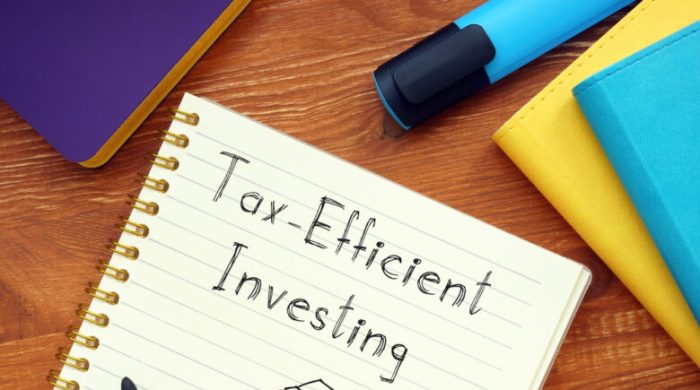Get ready to dive into the world of tax-efficient investing, where savvy financial moves can help you keep more of your hard-earned money. From smart asset allocation to strategic tax-loss harvesting, we’ll explore the ins and outs of making your investments work smarter, not harder.
What is Tax-Efficient Investing?
Tax-efficient investing refers to the strategy of maximizing investment returns while minimizing tax liabilities. It is an essential component of financial planning as it allows investors to keep more of their hard-earned money by managing their investments in a tax-efficient manner.
Differences from Traditional Investing
Tax-efficient investing differs from traditional investing strategies in that it focuses on reducing the tax consequences of investment decisions. This involves taking advantage of tax-advantaged accounts, such as IRAs or 401(k)s, and investing in vehicles that are inherently tax-efficient, such as index funds, ETFs, or municipal bonds.
Examples of Tax-Efficient Investment Vehicles
When it comes to tax-efficient investing, investors can consider a variety of investment vehicles. Some examples include:
- Index Funds: These funds track a specific index, such as the S&P 500, and tend to have lower turnover rates, resulting in fewer capital gains distributions and lower tax liabilities.
- ETFs (Exchange-Traded Funds): Similar to index funds, ETFs offer diversification and tax efficiency, as they are structured to minimize capital gains distributions.
- Municipal Bonds: Municipal bonds are debt securities issued by state and local governments, offering tax-free income for investors in certain situations.
Benefits of Tax-Efficient Investing
Engaging in tax-efficient investing can provide several benefits, including:
- Maximizing Returns: By minimizing taxes, investors can keep more of their investment gains, leading to higher overall returns.
- Minimizing Tax Liabilities: Utilizing tax-efficient strategies can help reduce the amount of taxes owed on investment gains, preserving wealth over the long term.
Strategies for Tax-Efficient Investing
When it comes to tax-efficient investing, there are several strategies you can employ to optimize your portfolio and minimize tax liabilities. These strategies include asset location, tax-loss harvesting, and dividend investing.
Asset Location
Asset location refers to the practice of strategically placing different types of investments in taxable and tax-advantaged accounts to minimize taxes. By allocating assets based on their tax efficiency, investors can optimize their overall tax situation. For example, placing tax-inefficient investments like bonds in tax-deferred accounts and tax-efficient investments like stocks in taxable accounts can help reduce taxable income and maximize after-tax returns.
Tax-Loss Harvesting
Tax-loss harvesting involves selling investments that have experienced a loss to offset gains and reduce taxable income. By realizing losses, investors can deduct up to $3,000 against ordinary income each year and carry forward any remaining losses to future years. This strategy can help investors lower their tax bill and improve overall portfolio performance.
Dividend Investing vs. Growth Stocks
When it comes to the tax implications of investing in dividend-paying stocks versus growth stocks, there are differences to consider. Dividend income is taxed at a higher rate than long-term capital gains, which can impact overall tax efficiency. Growth stocks, on the other hand, typically do not pay dividends, which can result in lower taxable income and potentially lower tax liabilities. Investors should weigh the tax implications of each strategy based on their individual financial goals and tax situation.
Tax-Efficient Investment Vehicles

Investors looking to minimize their tax burden can take advantage of various tax-efficient investment vehicles. These investment accounts offer specific tax benefits that can help individuals save on taxes and grow their wealth more effectively.
Roth IRAs
Roth IRAs are retirement accounts that allow individuals to contribute after-tax money, which then grows tax-free. The key tax advantage of a Roth IRA is that withdrawals in retirement are tax-free, including any earnings on the investments. This can be a powerful tool for tax-efficient investing as it allows for tax-free growth over time.
401(k) Plans
401(k) plans are employer-sponsored retirement accounts that offer tax benefits to employees. Contributions to a traditional 401(k) are made with pre-tax dollars, reducing taxable income in the current year. Additionally, the investments within the account grow tax-deferred until retirement when withdrawals are taxed at ordinary income tax rates. This tax deferral can help investors save on taxes over the long term.
Health Savings Accounts (HSAs)
HSAs are accounts specifically designed to help individuals save for medical expenses. Contributions to an HSA are tax-deductible, grow tax-free, and withdrawals for qualified medical expenses are also tax-free. HSAs offer a triple tax advantage, making them a powerful tool for tax-efficient investing, especially for those with high deductible health plans.
Impact of Taxes on Investment Returns
Taxes can have a significant impact on investment returns, reducing the overall profitability of an investment portfolio. It is crucial for investors to consider tax implications when making investment decisions to maximize after-tax returns.
Effect of Taxes on Investment Returns
When taxes are applied to investment gains, they can erode returns over time. For example, capital gains taxes can reduce the amount of profit an investor ultimately receives from an investment. It is essential to understand how different types of taxes, such as income taxes, capital gains taxes, and dividend taxes, can affect overall investment returns.
Strategies to Mitigate Tax Consequences
- Utilize tax-advantaged accounts like IRAs or 401(k)s to defer taxes on investment gains.
- Consider tax-loss harvesting to offset gains with losses and reduce tax liabilities.
- Invest in tax-efficient funds that minimize distributions and tax exposure.
Tax Drag and Its Impact
Tax drag refers to the reduction in investment returns caused by taxes. It can have a compounding effect over time, significantly impacting the overall performance of an investment portfolio. By minimizing tax drag through tax-efficient investing strategies, investors can enhance their after-tax returns.
Tips for Optimizing After-Tax Returns
- Hold investments for the long term to benefit from lower capital gains tax rates.
- Avoid frequent trading, which can trigger short-term capital gains taxes at higher rates.
- Stay informed about changes in tax laws and regulations that may affect investment returns.